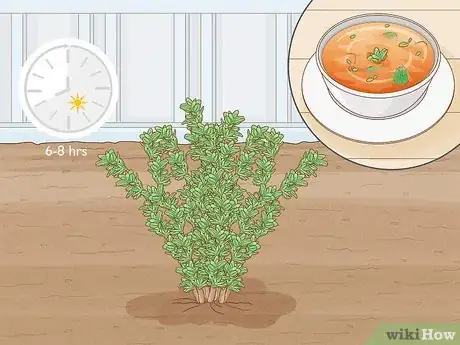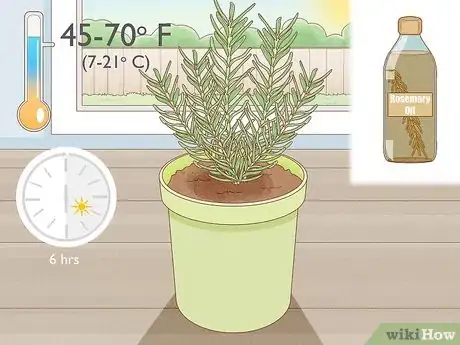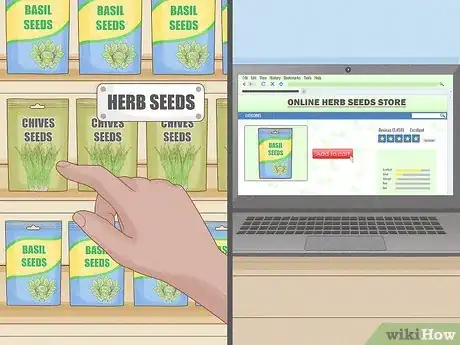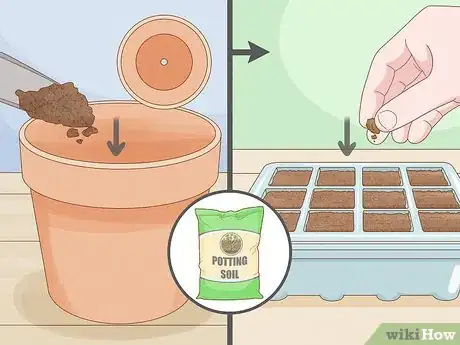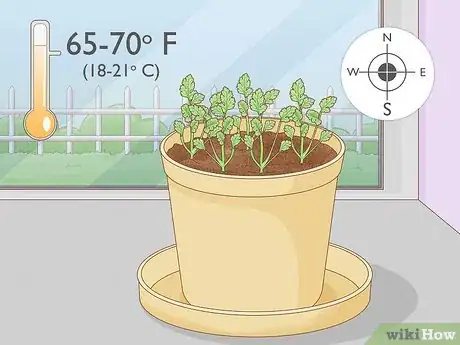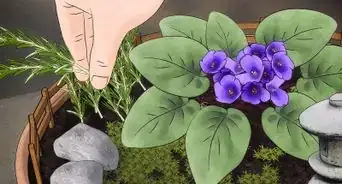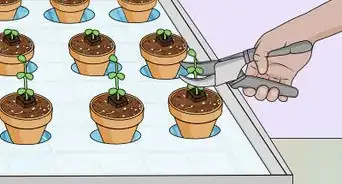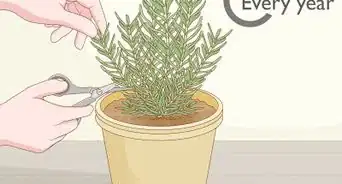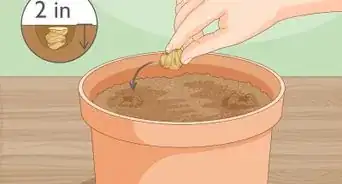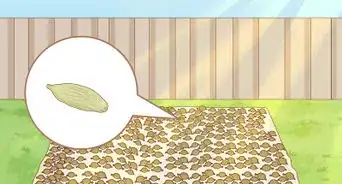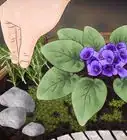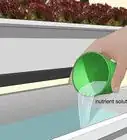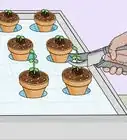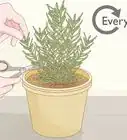This article was co-authored by Chai Saechao. Chai Saechao is the Founder and Owner of Plant Therapy, an indoor-plant store founded in 2018 based in San Francisco, California. As a self-described plant doctor, he believes in the therapeutic power of plants, hoping to keep sharing his love of plants with anyone willing to listen and learn.
There are 7 references cited in this article, which can be found at the bottom of the page.
This article has been viewed 451,692 times.
Herbs like basil, parsley, thyme, and oregano are great additions to your indoor plants, and they'll lead to lots of yummy foods! Once you decide which kind of herbs you'd like to grow, either plant the seeds in some nutrient-rich soil, take a cutting from a previous plant, or buy a little baby herb plant that's ready to grow. Herbs need at least 4-6 hours of sunlight a day to be healthy, so make sure you place them in a spot where they'll receive the best care.
Steps
Choosing Your Herbs
-
1Plant chives for an onion-flavored herb. Chives are a relatively low-maintenance herb to grow—they require about 4-6 hours of sunlight a day and a temperature between 55 °F (13 °C) and 75 °F (24 °C).[1]
- Use chives in garnishes, salads, sauces, or soups, just to name a few.
- Plant chives seeds in nutrient-rich soil.
-
2Select parsley for a sun-loving plant. You can start parsley from seed easily or buy a baby parsley plant. Parsley is a great herb to add flavor to your food, and it does well in fluctuating temperatures.[2]
- Use parsley on foods like chicken, roasts, fish, grilled steaks, or vegetables.
- Look for a healthy, green parsley plant at your local nursery, or give it lots of sunlight and rich soil if you're planting it from seed.
Advertisement -
3Grow oregano for an herb rich in antioxidants. You can either purchase a baby oregano plant to keep indoors, or you can take a cutting from an oregano plant you might already have outside. Give oregano plenty of sunlight and well-draining soil.[3]
- Oregano is often used on pizzas, in sauces, or mixed in with salad.
- Take a cutting by removing a healthy section of the oregano and placing it in a cup of fresh water.
-
4Pick out a thyme plant to provide great flavor. Thyme needs lots of sunlight—at least 6-8 hours a day or more. It does well in fluctuating temperatures and likes soil that drains well.[4]
- Use thyme in soups, stews, and sauces.
- Find a thyme plant at your local nursery or garden store.
-
5Sow basil seeds to grow healthy basil plants. Basil can be a bit tricky to grow, but it’s easiest if you start from seeds. Basil needs constant warmth, so it’s not a great herb to grow next to cool windows or in a climate where the temperature drops a significant amount at night.[5]
- Basil is used to make pesto and many other pasta dishes, as well as to treat several different ailments.
- Keep basil warm near a window and avoid letting it feel a drop in temperature.
- If you’re purchasing basil seeds online, make sure you look for a reliable seed seller.
-
6Cultivate rosemary for an aromatic herb. Rosemary does well if you take a cutting from a grown plant, or you can purchase a baby rosemary plant that’s ready to be cared for. Rosemary does well as long as the temperature stays between 45 °F (7 °C) and 70 °F (21 °C), and it likes at least 6 hours of sunlight.[6]
- Use rosemary in vinegars, oils, or sauces, among others.
- Cut off a section of a rosemary plant and stick it in a cup of water to watch it grow roots.
-
7Choose sage for strong flavor and health benefits. Either buy a sage plant from your local nursery or take a sage cutting and grow it in a pot. Sage needs well-draining soil and full sun, but it can tolerate dry air well.[7]
- Sage goes well with many different types of meats, but it’s quite strong, so use it in small amounts.
- Visit your local nursery to find a baby sage plant or cut off a section of an already-grown sage plant to watch roots form in a cup of water.
Starting from Seed
-
1Purchase your seeds from a reliable source. You can visit your local nursery or garden store to pick out seeds of the herb you’d like to grow, or you can purchase seed packets online. Many seed packets come with over 100 seeds each, providing you with plenty of seeds.
- Reliable sources have a good reputation and positive buyer reviews.
- You can also ask your local nursery or garden store employees where they recommend buying seeds online.
-
2Prepare a container with nutrient-rich soil. The container should have drainage holes to let water pass through—clay pots are a good option, as are tiny seed trays designed for growing lots of different sections of seeds. Fill ¾ of the container with well-draining potting soil.[8]
- You can find nutrient-rich potting soil at a garden or home improvement store.
- Seed trays have multiple cells, perfect for growing several different seeds or herbs at once.
-
3Sprinkle a few seeds into the container. If you’re using small seed trays, scatter 2-3 seeds in each tray. If you’re using a larger pot, you may want to sprinkle about 5 seeds into the soil, just in case some of them don’t sprout.[9]
- Spread the seeds evenly so that none of them are on top of each other.
-
4Cover the seeds with a fine layer of soil. Sprinkle just enough soil over the seeds so that they’re not exposed—a thickness of about 1 centimetre (0.39 in) is good. A thin layer of soil will protect the seeds while allowing the small seedling to sprout through the soil.[10]
- Don’t pack down the soil once you spread it in the container.
-
5Place the container in a warm spot with dappled light. Once the seeds have been planted, set the container near a warm window that receives lots of light or in a warm room.[11]
- It’s not necessary for the seeds to be in direct sunlight while they germinate.
-
6Use a spray bottle to water the seeds. Fill up a spray bottle full of water and mist the soil. If you’re not sure if you’ve watered them enough, let the water soak in for about an hour and check on the seeds again—if the soil is dry, it could need more water.[12]
- Make sure you use a saucer or plastic tray underneath the container to catch any water that drains out.
- Use a piece of plastic to cover the container to keep moisture inside of the soil.
Caring for the Herbs
-
1Use a saucer or drain pan to catch excess water. It's common for the plant to release water through the drainage holes in its container when it has too much. Placing some sort of liner underneath the container will not only keep water from leaking everywhere, but it will also protect your surface.[13]
- Opt for drain pans made of plastic or rubber as opposed to clay—clay lets water pass through more easily.
-
2Keep the herbs in a warm, sunny environment. Herbs like a temperature of about 65–70 °F (18–21 °C) indoors, as well as some indirect sunlight. If the temperature outside drops a bit at night, this is okay for most plants as long as it warms back up in the morning.[14]
- Place the herbs in a south-facing window, if possible.
- Basil is one exception—it doesn’t like cool weather and will start drooping if the temperature drops.
- Keep the leaves from touching the glass window to prevent it from getting too hot or too cold.
-
3Set up artificial light sources to help the herbs grow. If the herbs aren’t able to get 6 hours of natural sunlight a day, purchase clamp-on reflector lights with fluorescent bulbs. You can set these lights 4–6 inches (10–15 cm) above the plants to provide sufficient lighting.[15]
- These lights can be kept on for up to 12 hours a day, depending on the plant's needs.
-
4Wait for the herbs to dry out before watering them. Most herbs don’t need constant watering. Check to see if the plant is dry, and if so, water the soil directly instead of pouring water all over the leaves and stem.[16]
- You can check to see if the herb has dried out by sticking your finger down into the soil near the roots. If this underground section feels dry, it’s time to water the plant.
- Don’t leave standing water in the drain pan—this can cause rot.
-
5Apply a liquid fertilizer to keep the herbs healthy. Herbs like fertilizers such as fish emulsion or liquid seaweed. When you’re picking out a fertilizer, avoid ones that promote blooms to keep the energy focused on creating new leaves.[17]
- Read the instructions on the fertilizer to determine how much to use on the herbs, as well as how often.
- Most fertilizers are applied every couple of weeks.
-
6Cut the herbs to encourage growth. Trimming your herbs frequently will cause new leaves to form, expanding your plant. Start from the top of the plant, cutting right below where a leaf meets the stem. You can also use your fingers to pinch off the leaves, as desired.[18]
- Never cut off more than one third of the plant.
- Use sharp, clean scissors or cutting shears.
Expert Q&A
-
QuestionCan you grow herbs inside your house?
 Chai SaechaoChai Saechao is the Founder and Owner of Plant Therapy, an indoor-plant store founded in 2018 based in San Francisco, California. As a self-described plant doctor, he believes in the therapeutic power of plants, hoping to keep sharing his love of plants with anyone willing to listen and learn.
Chai SaechaoChai Saechao is the Founder and Owner of Plant Therapy, an indoor-plant store founded in 2018 based in San Francisco, California. As a self-described plant doctor, he believes in the therapeutic power of plants, hoping to keep sharing his love of plants with anyone willing to listen and learn.
Plant Specialist Yes, but it can be tricky. You have to be careful about the plants' sun and moisture levels.
Yes, but it can be tricky. You have to be careful about the plants' sun and moisture levels. -
QuestionIs it safe to give herbs tomato feed?
 Community AnswerGiving tomato feed to herbs is not recommended. Tomato feeds are high in phosphorus, which promotes bloom and fruit. Herbs are grown for their leaves. Because herbs taste best when they don't have flowers, you should instead use a high nitrogen fertilizer, which encourages leaf growth.
Community AnswerGiving tomato feed to herbs is not recommended. Tomato feeds are high in phosphorus, which promotes bloom and fruit. Herbs are grown for their leaves. Because herbs taste best when they don't have flowers, you should instead use a high nitrogen fertilizer, which encourages leaf growth. -
QuestionCan I save my herb plant that has brown leaves that are falling off?
 TheindoorgardensCommunity AnswerTake a look at the amount of water you're giving to the plant. Check about an inch or so down and make sure it's dry before watering it. One of the signs of root rot is yellowing and dying leaves. Many people think this is due to lack of water, and therefore water more, compounding the problem.
TheindoorgardensCommunity AnswerTake a look at the amount of water you're giving to the plant. Check about an inch or so down and make sure it's dry before watering it. One of the signs of root rot is yellowing and dying leaves. Many people think this is due to lack of water, and therefore water more, compounding the problem.
Warnings
- Avoid getting fertilizer on the leaves, as you might be eating them.⧼thumbs_response⧽
- Overwatering is the biggest cause of herb issues. Always make sure the herb actually needs water before watering it.⧼thumbs_response⧽
- Yellowing leaves can be a sign of overwatering and root rot.⧼thumbs_response⧽
- If you see your herbs growing longer stems and fewer leaves, this might mean that they’re not getting enough sunlight.⧼thumbs_response⧽
References
- ↑ https://growagoodlife.com/grow-herbs-indoors/
- ↑ https://growagoodlife.com/grow-herbs-indoors/
- ↑ https://growagoodlife.com/grow-herbs-indoors/
- ↑ https://www.more.com/living/stylish-home/9-easiest-herbs-grow-indoors
- ↑ https://www.more.com/living/stylish-home/9-easiest-herbs-grow-indoors
- ↑ https://growagoodlife.com/grow-herbs-indoors/
- ↑ https://www.almanac.com/plant/sage
- ↑ https://garden.org/learn/articles/view/4056/
- ↑ https://www.bhg.com/gardening/vegetable/herbs/starting-herbs-from-seed/
- ↑ https://www.bhg.com/gardening/vegetable/herbs/starting-herbs-from-seed/
- ↑ https://garden.org/learn/articles/view/4056/
- ↑ https://garden.org/learn/articles/view/4056/
- ↑ https://bonnieplants.com/library/how-to-grow-herbs-indoors/#
- ↑ https://bonnieplants.com/library/how-to-grow-herbs-indoors/#
- ↑ https://www.chowhound.com/food-news/54973/how-to-grow-herbs-indoors/
- ↑ https://www.chowhound.com/food-news/54973/how-to-grow-herbs-indoors/
- ↑ https://www.chowhound.com/food-news/54973/how-to-grow-herbs-indoors/
- ↑ https://www.chowhound.com/food-news/54973/how-to-grow-herbs-indoors/
About This Article
To grow an herb garden indoors year round, start by purchasing seeds from your local nursery or garden store. You will also need some pots to plant them in, which you should fill ¾ of the way full with potting soil. Plant the seeds about 1 cm apart from each other and then cover them with a sprinkle of soil. Keep your herbs near a warm window that receives lots of light, ideally where it is about 65–70 °F. To water your herbs, fill up a spray bottle full of water and mist the soil when it becomes dry to the touch. To learn how to choose your herbs, read on!



